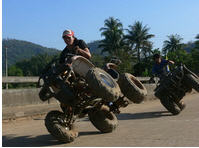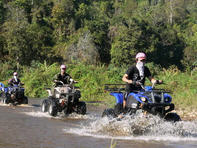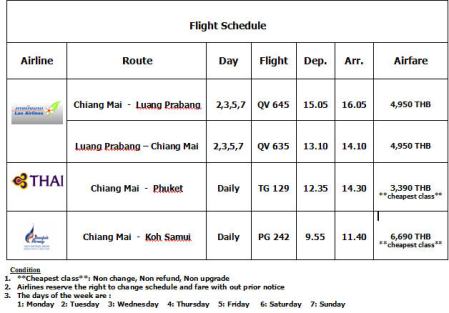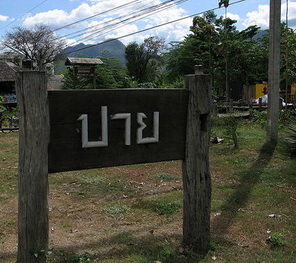The best adventure in Chiangmai
I enjoy getting lost. Taking a map, my camera, some water, and follow some deserted mountain road, looking down on valleys, looking over mountain ranges. This is how I found the beautiful little village of Baan Namkhong just a few weeks ago at the end of a winding road, in an area where my maps show absolutely nothing. They couldn’t be more wrong. At the altitude of 1050 metres, this little community is surrounded by ancient lush jungle, huge timeless rubber trees, amazing green scenery, and deep silence and serenity.
That is, until an adrenalin-fuelled scream breaks the silence.
This is the home of Jungle Flight, Chiang Mai’s ultimate jungle adventure: sliding from giant tree to giant tree on cables for over two kilometres, sometimes as high as 40 metres above ground. It is difficult to let go, to jump into thin air at first, but then, the flow carries you away quickly. If you are longing for some thrill, but bungee jumping is a bit steep for you, I think Jungle Flight is just what you have been looking for. However, you will find yourself at the end of a rope all the same, and I tell you that tree is coming real fast as well!
tree up close!
Take a deep breath. Just let it happen to you. Once the first adrenaline rush is over, and those shaking legs support you firmly again, you will find yourself looking at the jungle from a completely different angle, surrounded by treetops, wild orchids – and the word “depth” gets a whole new meaning. There is something timeless and ancient about Jungle Flight, which in a way reminds me of snorkelling.
silent giants
Our guides Pang and Yud are great with people, they know how to make people relaxed, how and when to tease or encourage. We all received lots of personal attention. The guides showed us coffee beans, flowers, a bees’ nest, gave us plenty of time to stop and admire the view, there was time for joking and fun.
When I asked what happens if someone doesn’t have enough momentum and stops in the middle of the cable, they showed me – they left me hanging there in the air, like a giant bird stuck in the canopy. That was the most carefree moment of my past couple of months, in the middle of nowhere. It is amazing too how quickly strangers bond on top of a tree.
It is a crazy idea to slide between trees when you first look at it, but at second glance, it looks perfectly safe. The longest and highest ziplines have two cables running parallel, and you get secured to both during your flight. The three abseil sections also have double safety lines. You are always attached to a wire while standing on any of the 22 platforms or walking the two wobbly skybridges. The guides hook you to the right places all the time, you cannot make a mistake. All equipment was imported, complies with international safety standards, and so does the safety training received by all the guides.
down here?! – no way!
At the very end, to descend from the last platform, you have no choice but to leap into the abyss – an eight-storey gap in the middle of a platform. You can ask to be lowered slowly or to have it with more of a free-fall twist. All I can say about this bit is that screaming actually does help.
There is a little bit of steep jungle walk back to the village, where a tasty lunch awaits the returning members of the expedition. You may also buy locally made herbal tea, honey, herbal pillows, or a Jungle Flight t-shirt. The restaurant overlooks the jungle and more giant trees, where you may wind down and share your favourite moments.
my favourite trees
The tour price is 2,200 baht for the entire 7-hour adventure, and includes round trip transfer, water, insurance, and a short stop at the local hot springs on the way back. You need to pay extra for lunch. If you choose an early pick-up time (6 to 6:30 a.m.) or a late afternoon adventure (leaving at 1-1:30 p.m.), the discounted price is 1,980 baht. You need to be taller than 120 centimetres and weigh less than 150 kilos to sign up.
that’s me at the end of my rope
Seven additional platforms will be completed by the end of April, including the longest zipwire in Thailand – 260 metres. There are plans for a daily ticket with unlimited number of rides. Personally, I can hardly wait for that one!
the longest cable at the moment – 130 metres
I think it is great value for money. First, it may sound too much for a daytrip, but just compare it to what the normal price of a bungee jump is. Jungle Flight takes three hours, you get to ride the longest zipline in Thailand, marvel at the jungle up close and from a bird’s eye view, and actually feel like a bird. It is as close as you can get to flying, something we all dream about. It is an adventure of a lifetime. The only problem is, you may get addicted!
jungle staircase
Your money also helps the local community. This little Khamu hilltribe village of 30 families is too high in the mountains for rice farming, so, the coffee plantations provide the main income. Jungle Flight brings in much needed income and jobs to the village while respecting the community. Part of the profits go towards funding a school van and school lunches to all children in the village, as well as towards maintaining the narrow winding road and providing clean water. Socially responsible businesses like Jungle Flight benefit local people, give them alternatives to cutting down the precious jungle, and are worthy of your support.
Baan Namkhong village
Also, a homestay scheme will be up and running in the near future, which should attract people looking for peace and quiet away from the city, overlooking the mountain ranges. The climate is noticeably more pleasant at this altitude, the trees are still green, an ideal place to escape to in the upcoming hot season.
The price includes transfer but if you would like to “get lost” on your own, head out of Chiang Mai on the Chiang Rai highway for 27 kilometres. At the sign to the Sankamphaeng hot springs, turn right and go a further 4 kilometres. Then follow the Jungle Flight signs for another 13 kilometres up the hills. It takes one hour to get there. A 105 cc motorcycle can just about make it, but that is not something I would like to try again.
I would like to thank the owner of Jungle Flight, Mr Songsai Mangklad (Sonny) for inviting me for a site inspection. Sonny gave me the grand tour personally and took care of me all along the way.
Bettie
http://www.thai-blogs.com, supported by Jungle Flight
quoted by http://www.queenbeetours.com









































